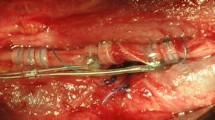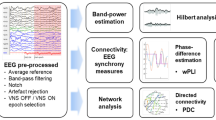Abstract
Vagus nerve stimulation (VNS) is used in pharmaco-resistant epilepsy to decrease the number of seizures. Although it is well known that VNS affects respiration, there are only a few reports concerning an effect of VNS on heart rate or heart rate variability (HRV). We investigated the relationship between respiratory frequency and the high frequency (HF) domain of the discrete Fourier transform (DFT) of the RR interval function during night sleep recordings of ten subjects treated with VNS. Our results show that VNS shifts the frequency of maximal power spectrum density (PSD) in the HF-band, decreases the related PSD and induces a partial cardiorespiratory decoupling.





Similar content being viewed by others
References
Akselrod S, Gordon D, Ubel FA, Shannon DC, Barger AC, Cohen RJ (1981) Power spectrum analysis of heart rate fluctuation: a quantitative probe of beat to beat cardiovascular control. Science 213:220–222
Arbor A (2000) ‘Brain Pacemaker’ for epilepsy may affect breathing during sleep, PSL Group. 2000. http://www.talkaboutsleep.com
Banzett RB, Guz A, Paydarfar D, Shea SA, Schachter SC, Lansing RW (1999) Cardiorespiratory variables and sensation during stimulation of the left vagus in patients with epilepsy. Epilepsy Res 35:1–11
Binks AP, Paydarfar D, Schachter SC, Guz A, Banzett RB (2001) High strength stimulation of the vagus nerve in awake humans: a lack of cardiorespiratory effects. Respir Physiol 127:125–133
Buoni S, Mariottini A, Pieri S, Zalaffi A, Farnetani MA, Strambi M, Palma L, Fois A (2004) Vagus nerve stimulation for drug-resistant epilepsy in children and young adults. Brain Dev 26:158–163
Camm AJ, Malik M (1996) Task force of The European society of cardiology and The North American society of pacing and electrophysiology. Heart rate variability. Standards of measurement, physiological interpretation, and clinical use. Eur Heart J 17:354–381
Finley JP, Nugent ST (1995) Heart rate variability in infants, children and young adults. J Auton Nerv Syst 51:103–108
Frei MG, Osorio I (2001) Left vagus nerve stimulation with the neurocybernetic prosthesis has complex effects on heart rate and on its variability in humans. Epilepsia 42:1007–1016
Galli R, Limbruno U, Pizzanelli C, Sean Giorgi F, Lutzemberger L, Strata G, Pataleo L, Mariani M, Iudice A, Murri L (2003) Analysis of RR variability in drug-resistant epilepsy patients chronically treated with vagus nerve stimulation. Auton Neurosci Basic Clin 107:52–59
Hallböök T, Lundgren J, Stjernqvist K, Blennow G, Strömblad L-G, Rosén I (2005) Vagus nerve stimulation in 15 children with therapy resistant epilepsy; its impact on cognition, quality of life, behaviour and mood. Seizure 14:504–513
Héberlé C, Berquin P, Larnicol N, Wallois F (2002) Vagus nerve stimulation in a case of epilepsy with CSWSS: respiratory side effects during sleep. Epilepsia 43(10):1268–1272
Kamath M, Upton A, Talalla A, Fallen E (1992) Effect of vagal nerve electrostimulation on the power spectrum of heart rate variability in man. Pacing Clin Electrophysiol 15:235–243
Kollai M, Mizsei G (1990) Respiratory sinus arrhythmia is a limited measure of cardiac parasympathetic control in man. J Physiol (London) 424:329–342
Lachaux J-P, Rodriguez E, Martinerie J, Adam C, Hasboun D, Varela FJ (2000) A quantitative study of gamma-band activity in human intracranial recordings triggered by visual stimuli. Eur J Neurosci 12:2608–2622
Litwin L (2000) FIR and IIR digital filters. IEEE Potentials pp 28–31
Lotric MB, Stefanovska A (2000) Synchronization and modulation in the human cardiorespiratory system. Physica A 283:451–461
Malow BA, Edwards J, Marzec M, Sagher O, Fromes G (2000) Effects of vagus nerve stimulation on respiration during sleep: a pilot study. Neurology 55(10):1450–1454
Marzec M, Edwards J, Sagher O, Fromes G, Malow BA (2003) Effects of vagus nerve stimulation on sleep-related breathing in epilepsy patients. Epilepsia 44(7):930–935
Murray DR (2003) What is “Heart rate variability” and is it blunted by tumor necrosis factor? Chest J 123:664–667
Osharina V, Wallois F, Bagaev V, Larnicol N (2006) Autonomic response and Fos protein expression in the NTS following intermittent vagus nerve stimulation in the rat: importance of pulse frequency. Autonomic Neuroscience, Basic and Clinical, Special Issue (in press)
Ponikowski P, Chua TP, Amadi AA, Piepoli M, Harrington D, Volterrani M, Colombo R, Mazzuero G, Giordano A, Coats AJS (1996) Detection and significance of a discrete very low frequency rhythm in RR interval variability in chronic congestive heart failure. Am J Cardiol 77:1320–1326
Pumprla J, Howorka K, Groves D, Chester M, Nolan J (2002) Functional assessment of heart rate variability: physiological basis and practical applications. Int J Card 84:1–14
Rosenblueth A, Simeone FA (1934) The interrelations of vagal and accelerator effects on the cardiac rate. Am J Physiol 110:42–55
Saper CB, Kibbe MR, Hurley KM, Spencer S, Holmes HR, Leahy KM, Needleman P (1990) Brain natriuretic peptide-like immunoreactive innervation of the cardiovascular and cerebrovascular system in the rat. Circ Res 67:1345–1354
Tatum WO, Moore DB, Stecker MM, Baltuch GH, French JA, Ferreira JA, Carney PM, Labar DR, Vale FL (1999) Ventricular asystole during vagus nerve stimulation for epilepsy in humans. Neurology 52:1267–1269
Vandenhouten R, Lambertz M, Langhorst P, Grebe R (2000) Nonstationary time series analysis applied to investigation of brainstem system dynamics. IEEE Trans Biomed Eng 47(6):729–737
Zaaimi B, Pruvost M, Grebe R, Wallois F, Berquin P (2005) Vagus nerve stimulation induces concomitant respiratory alterations and a decrease in SaO2 in children. Epilepsia 46(11):1802–1809
Acknowledgements
We thank the technicians staff of University Hospital for the data recordings. This work was supported by Jules Verne University of Picardie, Regional University Hospital, Homme, Technologie Systèmes Complexes program (HTSC), Conseil Régional de Picardie, European Social Funds, Fondation pour l’Avenir and Cyberonics.
Author information
Authors and Affiliations
Corresponding author
Rights and permissions
About this article
Cite this article
Pruvost, M., Zaaimi, B., Grebe, R. et al. Cardiorespiratory effects induced by vagus nerve stimulation in epileptic children. Med Bio Eng Comput 44, 338–347 (2006). https://doi.org/10.1007/s11517-006-0041-5
Received:
Accepted:
Published:
Issue Date:
DOI: https://doi.org/10.1007/s11517-006-0041-5




